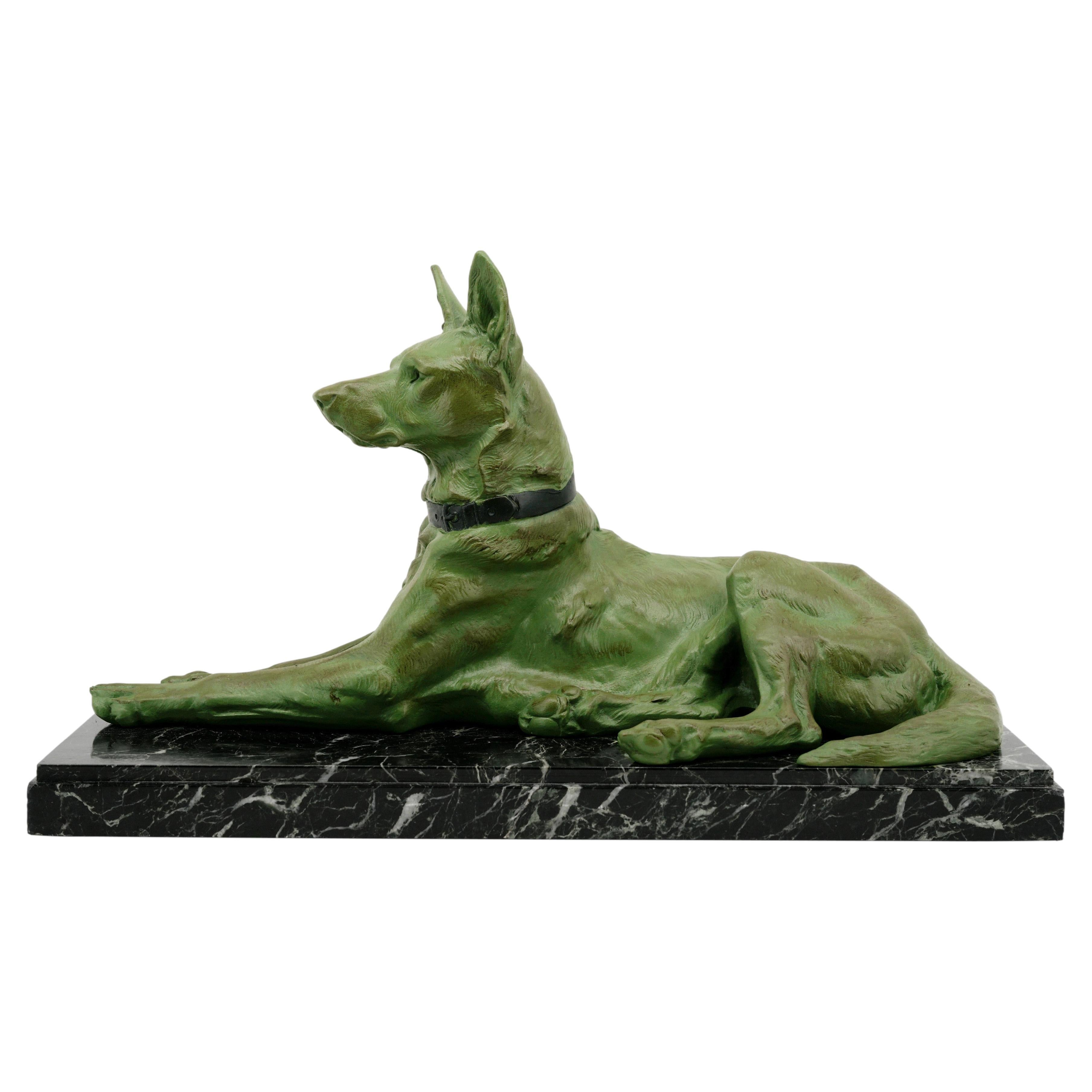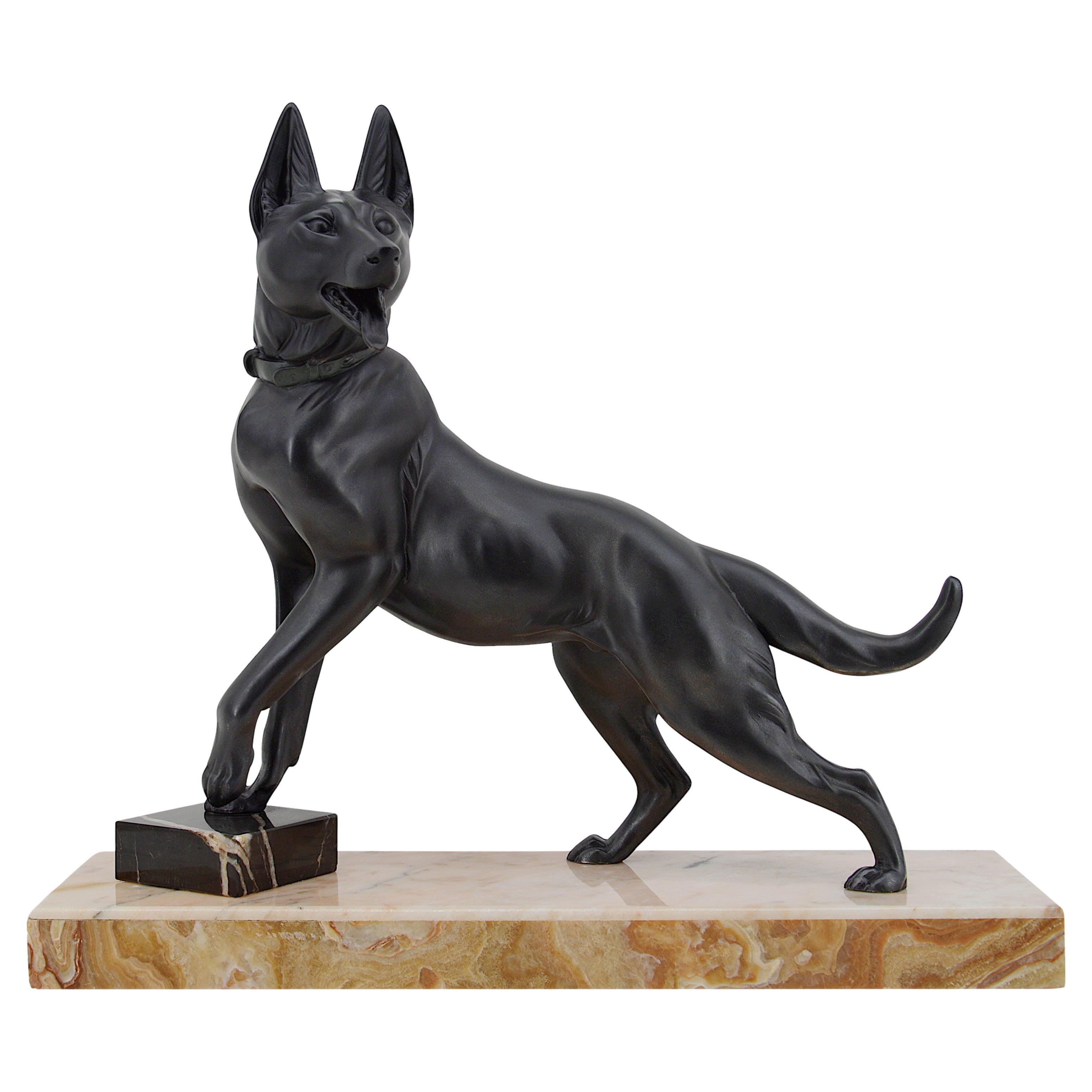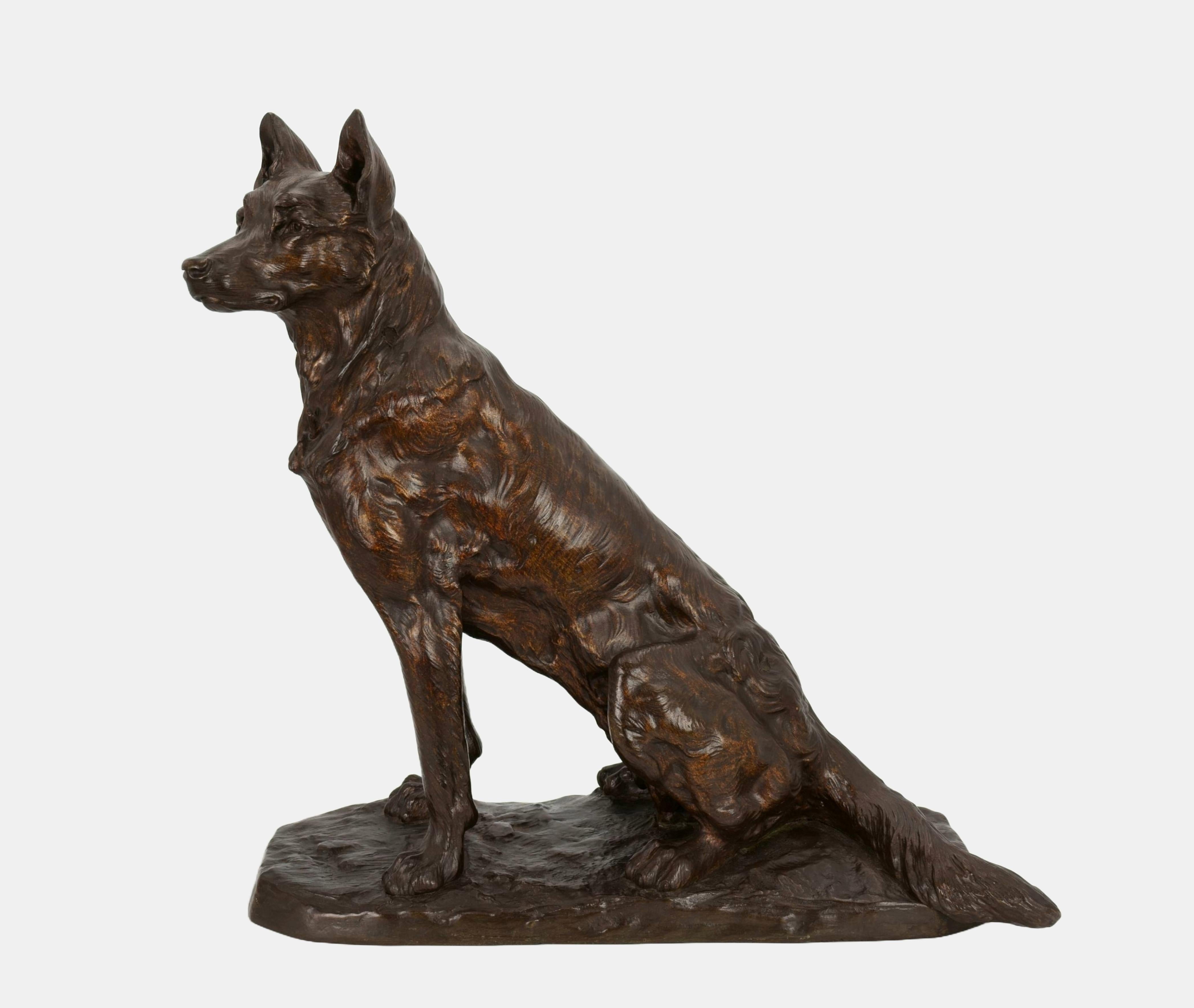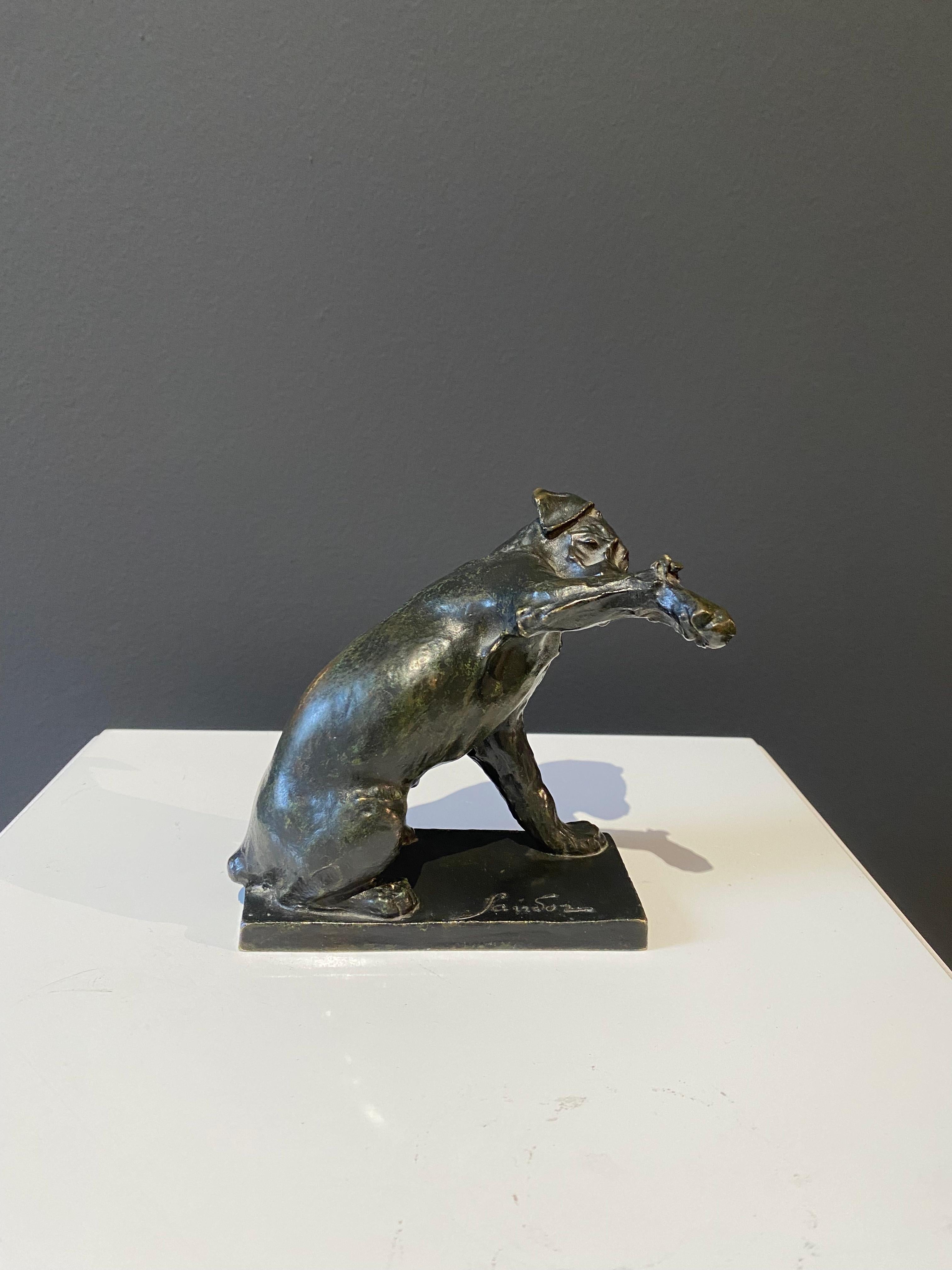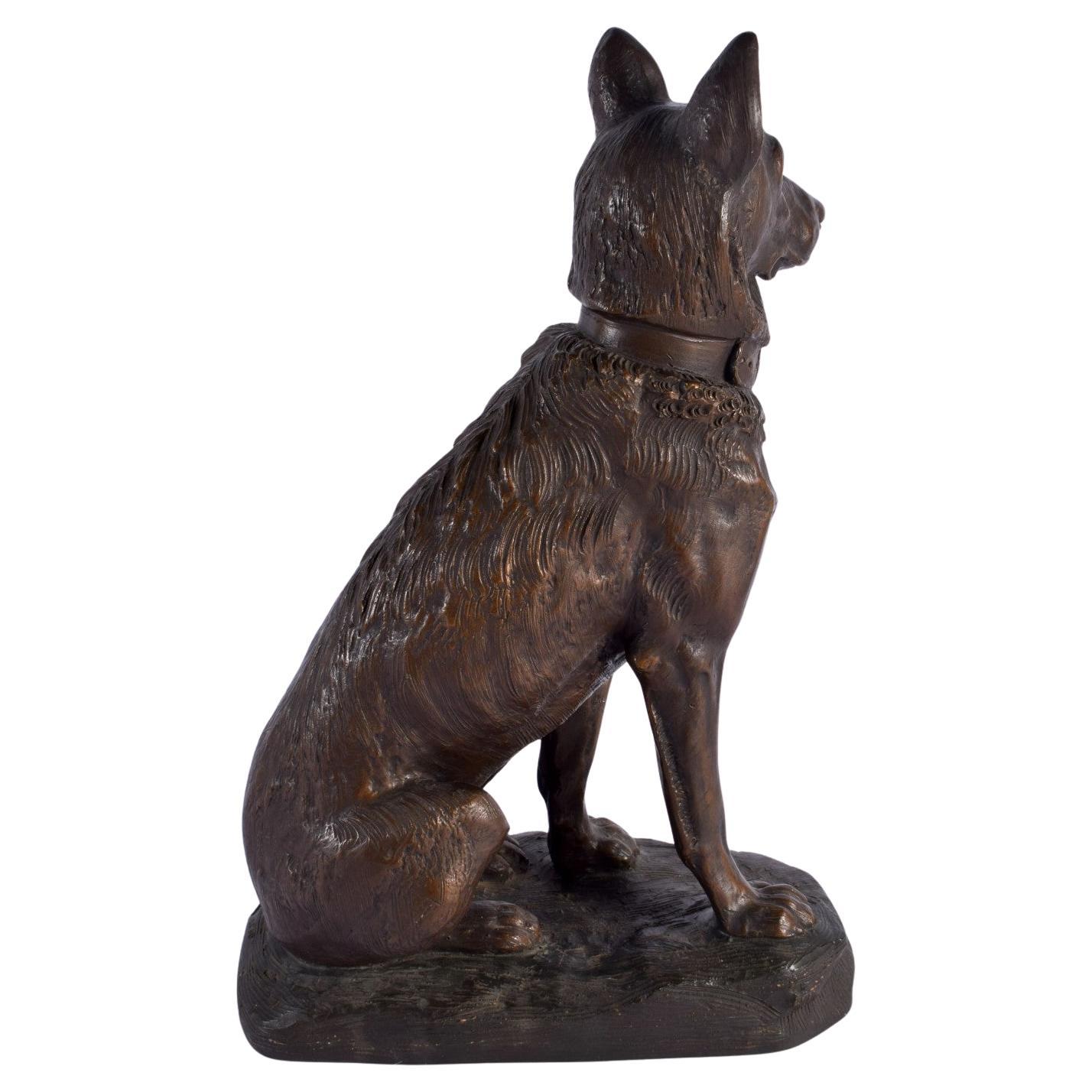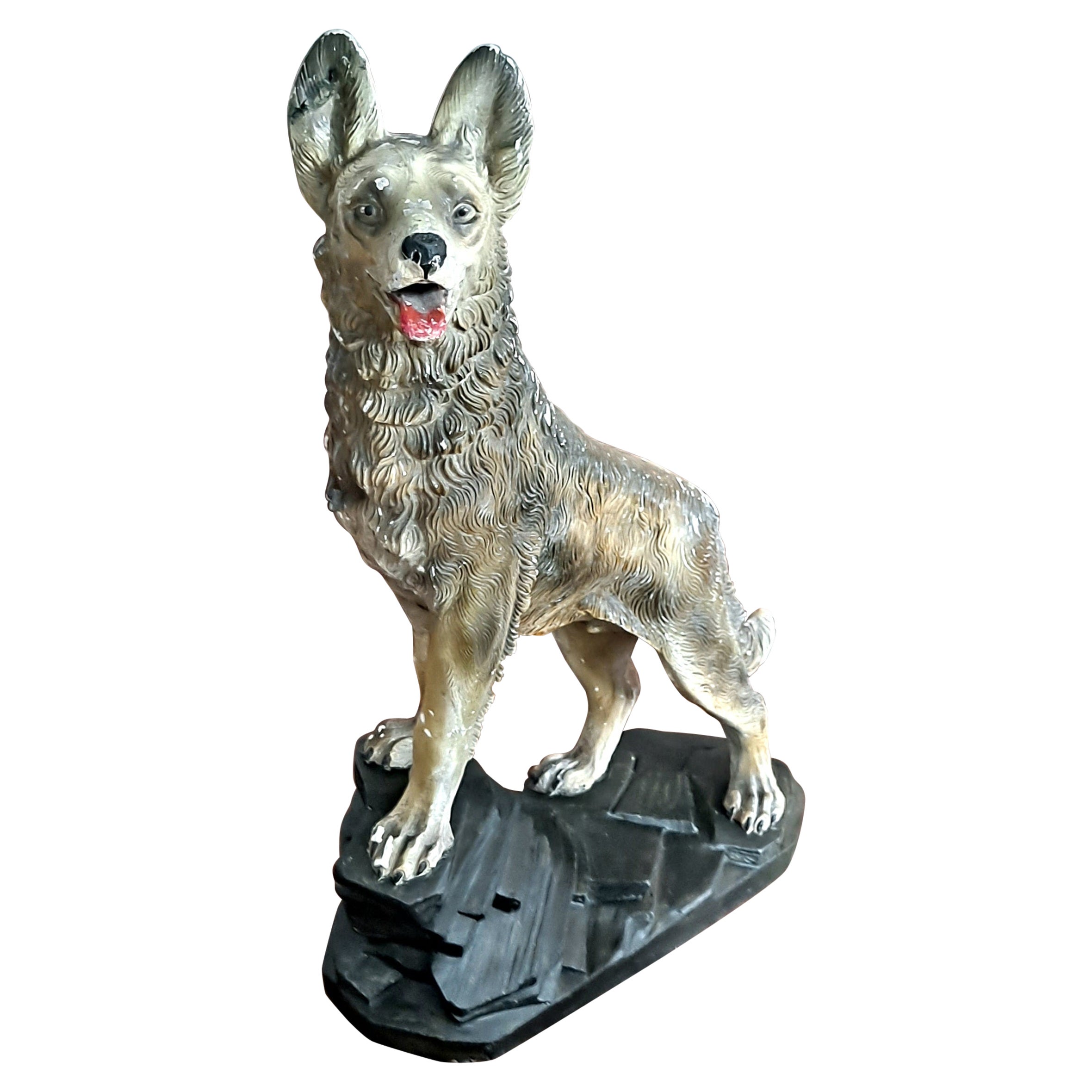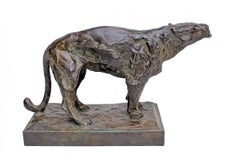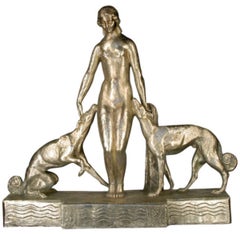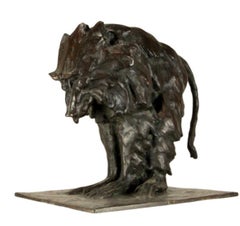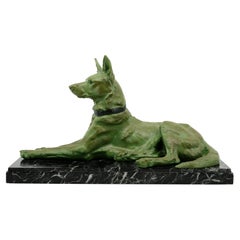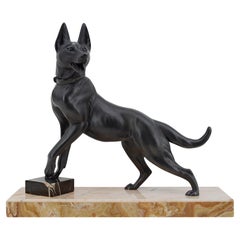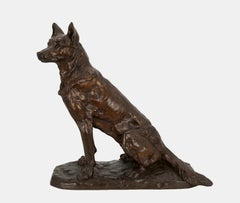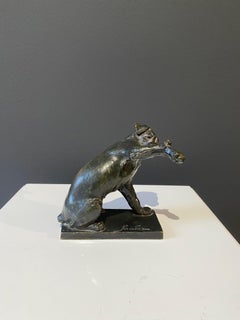Items Similar to Georges-Lucien GUYOT (1885-1973) German Shepherd Dog
Want more images or videos?
Request additional images or videos from the seller
1 of 6
Georges-Lucien GUYOTGeorges-Lucien GUYOT (1885-1973) German Shepherd Dog
$8,237.24
£6,130.95
€6,875
CA$11,282.96
A$12,549.11
CHF 6,552.76
MX$152,709.32
NOK 83,688.68
SEK 78,485.22
DKK 52,336.97
Shipping
Retrieving quote...The 1stDibs Promise:
Authenticity Guarantee,
Money-Back Guarantee,
24-Hour Cancellation
About the Item
Lying German Shepard Dog
A bronze cast of a resting German Shepard Dog, by Georges-Lucien Guyot (1885-1973). An early work, and a cast of 1920 with a brown patina with some reddish undertones and white yellow highlights. Signed G.L. Guyot and numbered 8656. On the inside of the cast marked with the Initials KH
Title: Lying German Shepard Dog
Measurements: 14,5 cm (h) x 55 cm (l) x 14 cm (w)
Material: Bronze cast
Signed: G.L. Guyot
Foundry mark: ? Marked on the inside with KH and numbered 8656
Georges-Lucien Guyot (1885-1973)
Georges Guyot was born in Paris, in the working class quarter of la Bastille where the majority of artisan craftsmen were based. By the time he reached adolescence his gift for drawing was apparent, and he was apprenticed to a local wood carver. Guyot discovers the works of Barye during a visiting to the Louvre, and he decides to change tack. He wants to make animal sculptures and learn to work with other materials. In 1904, during his military service in Rouen, he is allowed to take several courses in the local art school.
In 1906, he exhibited for the first time at the Salon des Artistes Français with a statue of a begging bear.
In 1909, he exhibited his first work in bronze and concentrated exclusively on sculpture from then on. In 1910, he was awarded a bronze medal. At this time he was exhibiting mainly depictions of dogs and a few busts. These first works were very realistic, but soon after he began to stylize his statues more while preserving naturalism.
At the outbreak of the First World War, Guyot was declared unfit for service on medical grounds. After the war he left the Salon des Artistes Français for the Salon des Indépendants, where he exhibited up until 1950. He also showed regularly at the Salon d’Automne. The Musée d’art Moderne acquired his Seated Bear in 1923, and his Ours Blanc enjoyed great success at the Salon des Indépendants.
Recurring themes in his work are bears, cats and monkeys. Besides a sculptor he was also a good painter, draughtsman and engraver.
Before the Second World War he had many solo exhibitions in some prestigious galleries including Bernheim Jeune, Druet, Devambez and Malesherbes. In 1943 the Salon des Indépendants organized a retrospective of his work. During the 1950s he enjoyed considerable international success. His last exhibition was held in 1972 shortly before his death in Paris. Guyot’s career unfolded with a roll call of successes and honours from the start. Over the years, his work was acquired by numerous French museums. The state also acquired numerous of his monumental pieces, and he always enjoyed acclaim from the critics, appreciation from art lovers, and recognition from his fellow artists, including high profile sculptors such as Pompon, who saw him as a real artistic personality. Pompon invited him in 1931 to join the group of 12 sculptors who exhibited at Ruhlman in Paris in 1932 and 1933.
His bronzes were cast by Susse Frères, Meroni-Radice, Godard and Valsuani. The posthumous bronzes are mostly cast by Fonderie de la Plaine. Some terracotta models have been edited by Susse and by Sèvres.
His work is part of several museum collections including the Museum of Modern Art of the City of Paris. A large bear by Guyot can also be found in the zoo in Vincennes. His work is also very popular among collectors of animal sculptures and is part of several large collections.
- Creator:Georges-Lucien GUYOT
- Dimensions:Height: 5.71 in (14.5 cm)Width: 21.66 in (55 cm)
- Medium:
- Period:
- Condition:
- Gallery Location:Gent, BE
- Reference Number:1stDibs: LU2140213861682
About the Seller
5.0
Vetted Professional Seller
Every seller passes strict standards for authenticity and reliability
Established in 2018
1stDibs seller since 2022
5 sales on 1stDibs
Typical response time: 1 hour
- ShippingRetrieving quote...Shipping from: Gent, Belgium
- Return Policy
Authenticity Guarantee
In the unlikely event there’s an issue with an item’s authenticity, contact us within 1 year for a full refund. DetailsMoney-Back Guarantee
If your item is not as described, is damaged in transit, or does not arrive, contact us within 7 days for a full refund. Details24-Hour Cancellation
You have a 24-hour grace period in which to reconsider your purchase, with no questions asked.Vetted Professional Sellers
Our world-class sellers must adhere to strict standards for service and quality, maintaining the integrity of our listings.Price-Match Guarantee
If you find that a seller listed the same item for a lower price elsewhere, we’ll match it.Trusted Global Delivery
Our best-in-class carrier network provides specialized shipping options worldwide, including custom delivery.More From This Seller
View AllRoaring Lionness
Located in Gent, VOV
A fine quality, twentieth-century bronze model of a roaring lioness by Alberic Collin (Belgian 1886-1962). Prior to casting by the Valsuani foundry it w...
Category
1930s Art Deco Figurative Sculptures
Materials
Bronze
Akop GURDJAN (après) (1881-1948) Sitting Baboon Bronze
Located in Gent, VOV
Akop GURDJAN (après)(1881-1948) Sitting Baboon Bronze
Akop Gurdjan (1881-1948)
Akop Gurdjan (also Hakob Gyurjyan) was born in Shusha (Nagorno Karabakh)...
Category
19th Century Figurative Sculptures
Materials
Bronze
Diana and the Hounds, a bronze sculpture by Giuseppe Joseph D’Aste (1881–1945)
Located in Gent, VOV
Diana and the Hounds by Giuseppe Joseph D’Aste is a finely executed silvered bronze sculpture from the 1920s, cast using the lost-wax (cire perdue) metho...
Category
Early 20th Century Nude Sculptures
Materials
Bronze
Guido Righetti Bronze Sacred Hamadryas Baboon (Model c. 1917)
Located in Gent, VOV
This rare and striking sculpture by Guido Righetti, titled Sacred Hamadryas Baboon, is a compelling study of the sacred primate rendered in a modern, expressive idiom. Modeled in 191...
Category
20th Century Modern Figurative Sculptures
Materials
Bronze
Polar Bears – Bronze by Marcel Debut (1865–1933), Art Deco Influence
Located in Gent, VOV
This rare bronze sculpture by Marcel Debut (1865–1933) presents a unique departure from his more frequently encountered mythological and allegorical themes, venturing into the realm of animalier sculpture. The piece depicts two polar bears, one resting and the other in an alert posture, rendered with a masterful blend of naturalism and expression. The textured modeling of the fur and musculature reflects Debut’s strong academic training while incorporating an impressionistic approach to surface treatment.
A notable aspect of this sculpture is its curved base, a subtle yet clear indication of Art Deco influence. Unlike traditional animalier works, which often rest on rigid, symmetrical bases, this dynamic foundation lends a sense of fluidity to the composition, reinforcing the motion and interaction between the two animals. This element suggests that the piece was created during the later period of Debut’s career, as Art Deco aesthetics—with their emphasis on stylized and elegant forms—began to shape sculptural design.
The choice of subject, polar bears, is also intriguing within the animalier tradition. While French sculptors of the late 19th and early 20th centuries frequently depicted felines, horses, and other terrestrial animals, this work stands out for its intimate, contemplative depiction of arctic wildlife. Rather than emphasizing a dramatic hunting or combat scene, Debut captures a quiet moment of interaction between the two bears, showcasing his ability to infuse emotion and realism into his subjects.
The patina of the bronze is rich and varied, enhancing the play of light on the textured surface and contributing to the lifelike quality of the sculpture. The artist’s signature “Debut” is clearly visible, further confirming its authenticity.
With its balance of academic realism, impressionistic texture, and Art Deco design principles, this bronze sculpture is a remarkable testament to Marcel Debut’s versatility as an artist. Its combination of naturalistic observation, expressive modeling, and modernist elegance makes it a rare and desirable piece within the canon of French animalier sculpture.
Category
20th Century Figurative Sculptures
Materials
Bronze
Josuë DUPON (1864-1935) Lying Lion Bronze (ca 1908)
Located in Gent, VOV
Lying Lion (Ca 1900)
A fine bronze sculpture of a lion lying on a rock. This statue by Josuë Dupon (1864 -1935) has a brown reddish patina with green high...
Category
19th Century Sculptures
Materials
Bronze
You May Also Like
German or Belgian Shepherd Sculpture 1910s
By Louis-Albert Carvin
Located in Saint-Amans-des-Cots, FR
Large German shepherd sculpture by Louis-Albert Carvin, France, 1910s. Spelter dog. Marble base. Height: 11.8"(30cm), Width: 20.5"(52cm), Depth: 8.5"(21.5cm). Stamp "Fabrication fran...
Category
Vintage 1910s French Art Deco Animal Sculptures
Materials
Marble, Spelter
Louis-Albert Carvin German Shepherd Sculpture, 1920
By Louis-Albert Carvin
Located in Saint-Amans-des-Cots, FR
Amazing huge German Shepherd sculpture by Louis-Albert Carvin, France, ca.1920. Spelter, marble and onyx. Spelter dog. Marble and onyx base. Height: 16.9"(43cm), width: 19.6"(49.8cm)...
Category
Vintage 1920s French Art Deco Animal Sculptures
Materials
Onyx, Marble, Spelter
Vigilant Sitting German Shepherd / - The Epitome of the German Shepherd -
Located in Berlin, DE
Albert Pierre LaPlanche (1854 Sainte-Menehould - 1935 Chäteau-Thierry), Vigilant sitting shepherd dog, around 1915. Brown patinated bronze on cast terrain plinth. 45 cm (height) x 45...
Category
1910s Realist Figurative Sculptures
Materials
Bronze
Chien à la sauterelle, Sandoz, Dog, Sculpture, Bronze, Animal, 1910's
By Edouard-Marcel Sandoz
Located in Geneva, CH
Chien à la sauterelle, Sandoz, Dog, Sculpture, Bronze, Animal, 1910's
Chien à la sauterelle
Susse Fondeur
circa 1918-1930
Bronze with brown patina and shade of green
13 x 13 x 9 cm
Signed and seal of the foundry on the base : Sandoz, Susse Fondeur
Catalogue raisonné de l'oeuvre sculpté de Edouard Marcel Sandoz, sculpteur figuriste et animalier 1881-1971, by Félix Marcilhac, Les Editions de l'amateur, 1993...
Category
1910s Modern Figurative Sculptures
Materials
Bronze
French Terracotta Dog, Alsation, Signed F Foucher
Located in York, GB
A very well sculptured large terracotta seated hound. Most likely of an alsation
This seated hound has very good detailing including the collar.His ears are pointed and he has a ve...
Category
Antique Late 19th Century French Animal Sculptures
Materials
Terracotta
German Shepard 1950 s Statue
Located in Los Angeles, CA
German Shepard 1950 s gesso Italian vintage statue .
Category
Vintage 1950s Italian Folk Art Animal Sculptures
Materials
Gesso
$680 Sale Price
20% Off
More Ways To Browse
Modern Dog Sculpture
Wood Cat Sculpture
George Bust
The Good Shepherd
White Patina Bronze Sculpture
German Shepherd
German Shepherds
Vintage Dog Statues
Wood Dog Sculpture
Bronze Patina Dog
Shepherd Dog
W Shepherd
Bronze Monkey
Large Bronze Bear Sculpture
Bronze Statue Germany
Vintage Wood Monkey
G Engraved Initial
Monkey German
